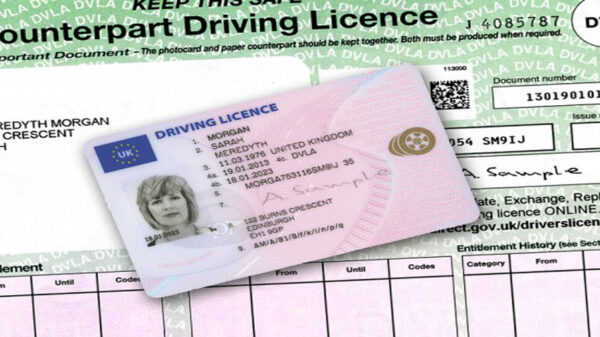Medical Conditions Drivers Must Declare to DVLA.
DVLA warns of 112 medical conditions drivers must declare or face a £1,000 fine. The list includes many common conditions, including anxiety and depression, which may impact on your ability to drive.
Drivers living with any of these 112 medical conditions could be at risk of a £1,000 fine if they don’t report their condition to licencing authorities.
The UK’s Driver and Vehicle Licencing Agency (DVLA) lists illnesses, conditions and disabilities which might impact on your ability to drive and which you may have to tell them about.
The government states you may be prosecuted if you’re involved in an accident as a result of an undeclared illness, The Daily Record reports.
For some of these conditions, you must tell the DVLA if you’re diagnosed with them, regardless of the impact you think it has on your ability to drive. Other conditions listed, such as anxiety or autistic spectrum conditions, may be reportable, but only if they impact on your ability to drive.
Once conditions are declared, the DVLA will decide if anything needs to be done. This could include having special controls fitted to your car, getting a new licence, or having a licence for a shorter period of time.
For a small number of the conditions, such as epileptic seizures, you’ll automatically have to give up your licence for a certain period if you’re diagnosed.
Additionally, according to the DVLA, you must give up your licence if any of the following are true:
>>> your doctor tells you to stop driving for 3 months or more
>>> your medical condition affects your ability to drive safely and lasts for 3 months or more
>>> you do not meet the required standards for driving because of your medical condition
Here is the full A-Z list of conditions that may be reportable. Visit the DVLA website to check the specific rules if you’ve been diagnosed with any of these conditions, below:
Absence seizures
Acoustic neuroma
Addison’s disease
Agoraphobia
AIDS
Alcohol problems
Alzheimer’s disease
Amaurosis fugax
Amputations
Amyotrophic Lateral Sclerosis (ALS)
Angina
Angioma
Angioplasty
Ankylosing spondylitis
Anorexia nervosa
Anxiety
Aortic aneurysm
Arachnoid cyst
Arrhythmia
Atrial defibrillator
Arteriovenous malformation
Artery occlusion
Arthritis
Asperger syndrome
Ataxia
Attention deficit hyperactivity disorder (ADHD)
Autistic spectrum condition
Balloon angioplasty (leg)
Behçet’s disease
Benign peripheral retinal pigmentation
Best’s disease
Bilateral artery occlusion (retinal)
Bipolar disorder
Blackouts
Blepharospasm
Blood clots
Blood pressure
Brachial plexus injury
Brain abscess, cyst or encephalitis
Brain aneurysm
Brain angioma
Brain haemorrhage
Brain injury (traumatic)
Brain tumours
Branch retinal vein occlusion
Broken limbs
Brugada syndrome
Burr hole surgery
Caesarean section
Cancer
Cataracts
Catheter ablation
Cardiac problems
Carotid artery stenosis
Cellophane retinopathy
Cataplexy
Central chorio retinopathy
Central serous retinopathy
Central vein occlusion
Central venous thrombosis
Cerebral palsy
Chemical eye burn
Chiari malformation
Choroidal infarction
Choroidal neovascular
Choroidal nevus
Choroiditis
Chronic aortic dissection
Chronic central serous retinopathy
Coats’ disease
Cogan’s dystrophy
Cognitive problems
Coloboma
Congenital heart disease
Convulsions
Corneal degeneration
Corneal graft
Coronary artery bypass or disease
Coronary angioplasty
Cranial arteritis
Cranial nerve palsy (without double vision)
Cupped optic disc
Cystic fibrosis
Cytomegalovirus
Deafness
Defibrillator
Déjà vu
Dementia
Depression
Detached retina
Diabetes
Diabetic retinopathy (with laser treatment)
Dilated cardiomyopathy
Diplopia (double vision)
Dizziness
Drug misuse
Duane syndrome (without double vision)
Eales
Eating disorders
Embolism (retinal)
Empyema (brain)
Epilepsy
Epiretinal membrane
Esophoria (without double vision)
Essential tremor
Estropia (without double vision)
Eye haemorrhage
Eye tumour
Fainting
Fits
Fractured skull
Friedreich’s ataxia
Fuch’s dystrophy
Fuch’s heterochromic cyclitis
Giant cell arteritis
Glaucoma
Global amnesia
Grand mal seizures
Guillain-Barré syndrome
Head injury
Heart attack
Heart arrhythmia
Heart failure
Heart murmurs
Heart palpitations
Heart valve disease or replacement valve
Hemianopia
Herpes zoster ophthalmicus
Heterophoria (without double vision)
High blood pressure
High myopia
HIV
Hodgkin’s lymphoma
Horner’s syndrome
Huntington’s disease
Hydrocephalus
Hypertension
Hypertrophic cardiomyopathy
Hypoglycaemia
Hypoxic brain damage
Hysterectomy
Implantable cardioverter defibrillator (ICD)
Intracerebral haemorrhage
Iris nevus
Ischaemic heart disease
Keratitis
Keratoconus
Kidney dialysis
Kidney problems
Korsakoff’s syndrome
Labyrinthitis
Learning difficulties
Left bundle branch block
Leukaemia
Lewy body dementia
Limb disability
Long QT syndrome
Low blood sugar
Lumboperitoneal shunt
Lung cancer
Lymphoma
Macular cyst
Macular degeneration
Macular hole
Macular oedema
Macular pucker
Maculopathy
Malignant brain tumours
Malignant melanoma
Manic depressive psychosis
Marfan’s syndrome
Medulloblastoma
Melanoma (ocular)
Memory problems (severe)
Meningioma
Mini-stroke
Monocular vision
Motor neurone disease
Multiple sclerosis
Muscular dystrophy
Myasthenia gravis
Myocardial infarction
Myoclonus
Narcolepsy
Neovascularistion of the optic nerve head
Neuritis (retrobulbar)
Night blindness
Nuclear sclerosis
Nystagmus
Obsessive compulsive disorder
Obstructive sleep apnoea
Ocular albinism
Ocular histoplasmosis
Ocular hypertension
Ocular myasthenia gravis (without double vision)
Ophthalmoplegia (without double vision)
Optic atrophy
Optic neuritis
Pacemakers
Palpitations
Paranoia
Paranoid schizophrenia
Paraplegia
Parkinson’s disease
Perifoveal atrophy
Peripapillary nevus
Peripheral arterial disease
Peripheral neuropathy
Personality disorder
Petit mal seizures
Pituitary tumour
Posner Schlossman syndrome
Post traumatic stress disorder (PTSD)
Posterior capsular opacification
Pseudophakia
Psychosis
Psychotic depression
Pulmonary arterial hypertension
Reis Bucklers corneal dystrophy
Renal dialysis
Retinal artery fugax
Retinal artery thrombosis
Retinal embolism
Retinal haemorrhage
Retinal occlusion (artery or vein)
Retinal photocoagulation
Retinal pigment epithelial atrophy
Retinal tear or detachment
Retinal treatment
Retinal vein thrombosis
Retinoblastoma
Retinopathy (with laser treatment)
Retinopathy fibroplasia
Retinopathy of prematurity
Retinoschisis
Retrobulbar neuritis
Schizo-affective disorder
Schizophrenia
Scotoma
Seizures
Severe communication disorders
Sight in one eye only
Sleep apnoea
Sleepiness (excessive)
Spinal problems and injuries
Squint (without double vision)
Strabismus (without double vision)
Stroke
Subarachnoid haemorrhage
Surgery
Syncope
Tachycardia
Temporal arteritis
Temporal lobe epilepsy
Thyroid related orbitopathy
Tonic clonic fits
Tourette’s syndrome
Transient global amnesia
Transient ischaemic attack
Tunnel vision
Usher syndrome
Uveitis
Valve disease or replacement valve
Vein occlusion
Ventricular defibrillator
Vertigo
Vision in one eye only
Visual acuity (reduced)
Visual field defects
Vitreous haemorrhage
VP shunts
Wolff-Parkinson-White syndrome
Find out more information on reporting guidelines for each of these conditions here.
Source: Newcastle Chronicle






















